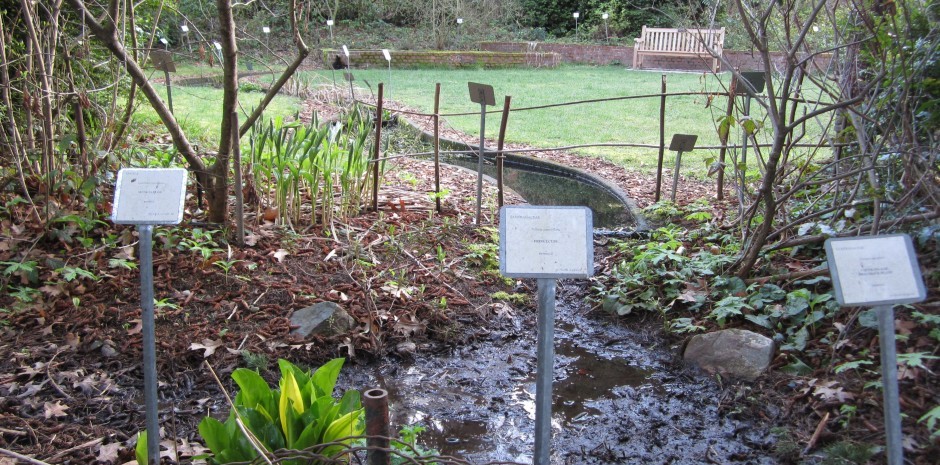Birdsong and maybe a baffling spring wind wafting through the conifers excepted, all is quiet in the Medicinal Herb Garden and the surrounding city, state, country and much of the world right now as we step out of our busy, daily routines and into social distancing and isolation at home as much as possible. We are doing a good job of ‘flattening the curve’ here in Washington state. It’s impressive to see fellow citizens engaged in this sort of enlightened self-interest because the lives of so many depend on it, both COVID-19 patients and those trying to heal them. Unfortunately, as businesses struggle or fail and the unemployment lines grow, that collateral damage becomes its own sad story.
Another story is also unfolding as volunteers band together to form ad hoc mutual aid associations to fill in for closed school cafeterias, by making meals for kids who need them, or sharing materials and making masks or using crowdfunding sites to help support closed neighborhood businesses and their employees, or getting supplies to the housebound. And on and on. It’s usually in hard times that we come to know what we’re made of, how well is woven our collective fabric. It’s looking pretty strong right now.
And with so many people staying home, their gardens are getting some love, and some gardeners are learning to grow their own food and herbs, just in time for the planting season. It’s likely we will come out of this pandemic with a more food-secure and hopefully, cooperative country, better prepared for the next natural disaster. That is definitely a good thing.
Though there are few human visitors right now, the Medicinal Herb Garden abides. It’s still early in the season but by May, the transplanting will be in full swing. If you see hand-written signs in front of new plants, be patient; reduced staffing at the UW might lead to a few delays.
We had a cold March but the garden is waking up. Here is barely a smattering of what you might see if you could safely manage a visit while maintaining current social distancing guidelines.

I didn’t get out early enough to take its picture before the sun got so bright but this is the Canadian serviceberry (Amelanchier canadensis). Fruit rust or no fruit rust, they are a beautiful small shrub or tree that should be more widely planted on city parking strips. Our western serviceberry (Amelanchier alnifolia) is smaller and usually shrubbier.

Very early stage of an umbrella plant (Darmera peltata) flower spike. It is growing in the little boggy area south of Cascara Circle, next to the…

western skunk cabbage (Lysichiton americanus) which can get over 4 feet tall, grows well in boggy areas and smells like a skunk.

Young cascara tree (Rhamnus purshiana). The seedlings come up all over near Cascara Circle. Its dried and aged bark is still used as a safe laxative. Birds eat its black, shiny fruit and they deposit the seeds very nearby (yes, the fruit are also laxative).

Sometimes people drop off their goldfish in the Cascara Circle cistern. Those fish rarely die of old age. One year when there was a proper school of them the size of brook trout, I spotted a great blue heron standing in the water. It ate every fish. Raccoons will also catch fish trapped in such a small area. I’m not sure if that’s what this rascal is doing.
Apparently they have many sensitive nerve endings in the pads of their forepaws and water increases the sensitivity. Here is a great entry on raccoons from PAWS:
https://www.paws.org/resources/raccoons/

Fern-leaved biscuitroot (Lomatium dissectum) in the morning light of section D. Its native range is on the hot, dry, eastern side of the Cascades so it needs to get up early in spring to beat the heat of summer.

Unopened flower buds of white-flowered asphodel (Asphodelus albus) in the north border of section D. When these buds open they will each transform into a long raceme of star-shaped white flowers which will turn into large, spherical seed capsules.

From South Africa, giant honey flower (Melianthus major) in the border of section E.
If you rub your fingers on its leaves, your fingers will smell like peanut butter. This plant is a little over 2 feet tall but can grow to a striking 8 feet or more. Unfortunately, a really cold winter will set it back in Seattle.

Blue cohosh (Caulophyllum thalictroides) in section D is up and ready to flower early like many herbaceous perennials of the eastern hardwood forests. They take advantage of the sunlight before the deciduous trees leaf out. The blue cohosh is doing better this spring, protected by rabbit fencing. Speaking of rabbits, they seem to be scarce in the garden these days, maybe because all of the fencing has closed off their sources of food or maybe they are in some sort of cyclical downturn.

The false unicorn (Chamaelirium luteum) seems to have found a place where it can thrive in section F. Its common name refers to its long, white flower spikes.

First tendrils of wild yam (Dioscorea villosa), nearly ready to start twining around their trellis in section F.

If you can’t bear the sight of any more daffodils (Narcissus pseudonarcissus) and need yellow spring flowers to fill a spot in your garden, there’s always oxlip (Primula elatior).
The young leaves are edible and the roots are diuretic and expectorant. These are in section F.

Last year’s growth still visible, the Syrian rue (Peganum harmala), desert plant though it is, has survived yet another Seattle winter. It would do better if it still got full sun exposure but had some overhanging tree branches to keep it drier in winter.

On our nearly deserted and eerily quiet campus, someone passed through and left this offering in Cascara Circle. It seemed like a good omen.
tulip tree petals
dandelions, daisies, sage
springtime mandala
See you in the garden…eventually.

